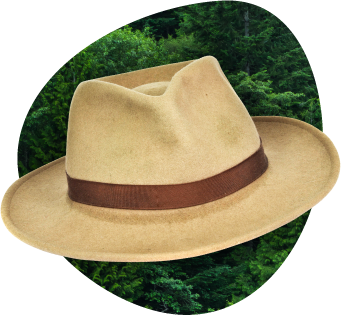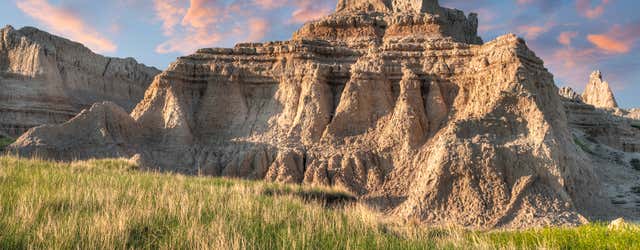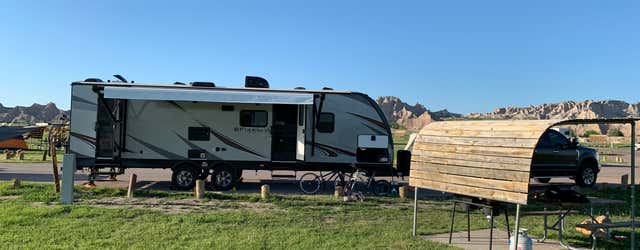
Planning a trip to Badlands National Park
With insider tips from real park rangers
With its rugged terrain, extreme temperatures, and lack of water, the Lakota people were the first to call this part of South Dakota “mako sica,” or “land bad.” Nineteenth-century French trappers, too, referred to the region as “mauvaises terres a traverser,” or “bad lands to travel across” because of the frustrating, maze-like landscape of spires, pinnacles, and hoodoos. Today, those same features, in addition to the park’s wide-open grasslands, draw more than a million visitors every year to marvel and learn about the park’s 75 million years of geological history.
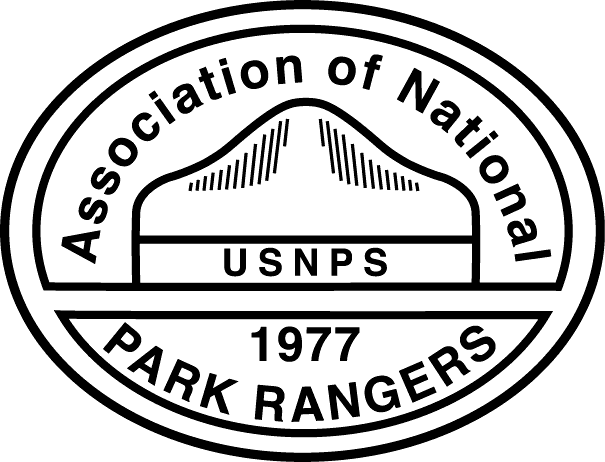
Written for you by park rangers
Who knows a national park best? Yep, the rangers who live and breathe its fresh, clean air every day. That’s who we turned to for help in creating this guide. Roadtrippers has partnered with the Association of National Park Rangers and convinced its rangers to spill their secrets for your benefit.
Getting to Bandlands National Park
Most visitors to Badlands National Park fly into Rapid City Regional Airport (RAP). A perfect place for an overnight stay, explore what Rapid City, aka the Gateway to the Black Hills, has to offer: the Journey Museum and Learning Center, The City of Presidents bronze statue collection in downtown, graffiti-filled Art Alley, and engaging Reptile Gardens, one of the largest reptile collections in the world and home to Maniac, the largest crocodile in the Northern Hemisphere. It’s a must-see, especially around feeding time!
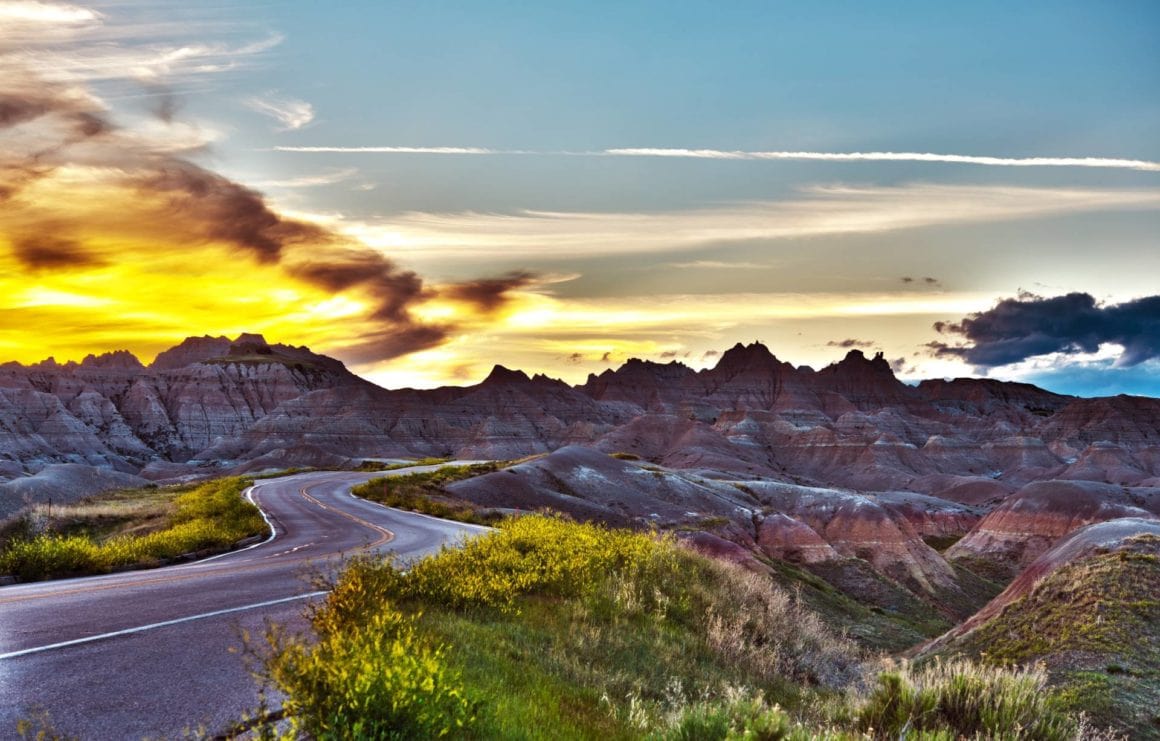
From Rapid City, make the one-hour drive along Highway 44 to the northeast entrance. Or better yet, take the slightly longer drive along Interstate 90 and consider making the following stops on the way:
Ellsworth Air Force Base
North of Rapid City, visit Ellsworth Air Force Base, home to the country’s biggest bombers. The base tour includes a stop at an official underground Minuteman missile silo. Because of security restrictions, the base tour is only available to U.S. citizens and resident aliens. You must show a Real ID-compliant driver’s license, military ID, or passport. Just outside the base, visit the South Dakota Air and Space Museum to see Cold War artifacts, aircraft, missiles, and more. The museum is free.
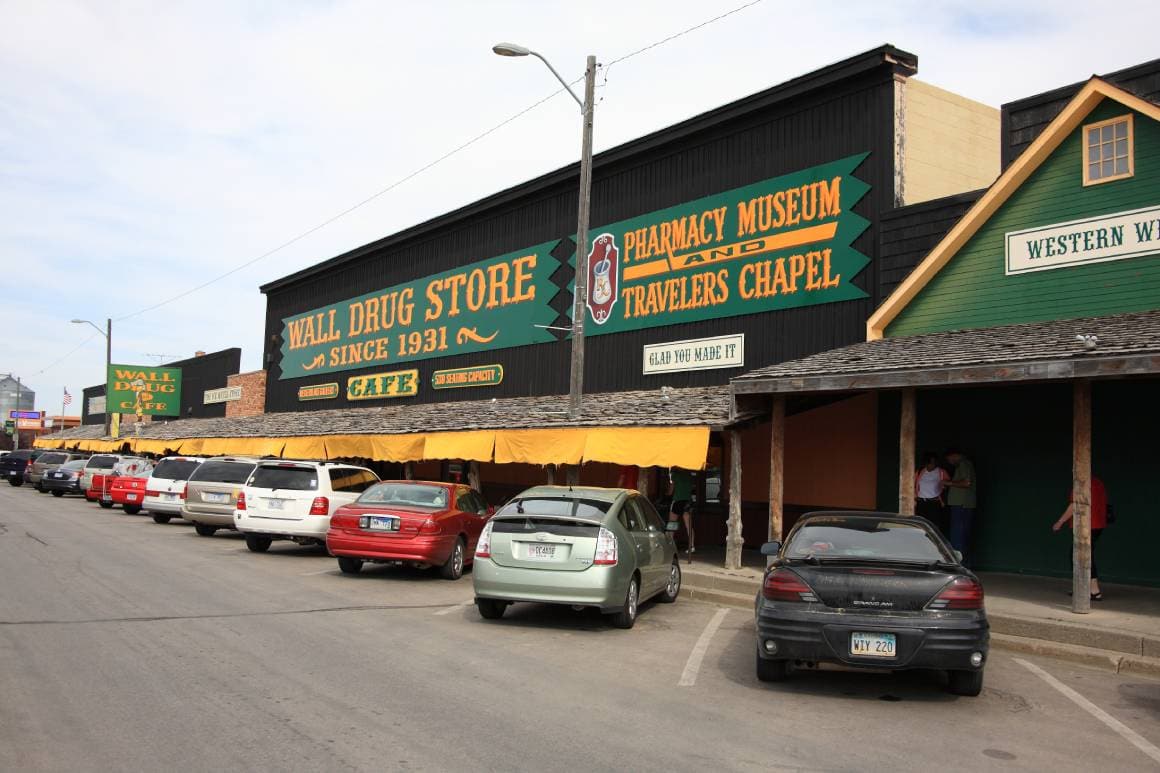
Wall Drug
When an owner goes to the trouble of posting 290 signs up and down the highway inviting you to visit, how can you not go? Wall Drug is the name of a collection of gift shops, restaurants, and photo op statues that encompass an entire block in the town of Wall. Started in 1931 by Ted and Dorothy Hustead with the promise of “free ice water” to thirsty Badlands visitors, it’s become one of the country’s favorite roadside attractions. Make sure to take your photo atop the famed jackalope.
Minuteman Missile Visitor Center
Continue on Interstate 90 to the Minuteman Missile Visitor Center where you can learn about South Dakota’s fascinating role in the Cold War. Did you know that there were 150 nuclear missiles in South Dakota that—if deployed—could have reached halfway around the world in 30 minutes?
Access to fuel is only dependable in the towns of Rapid City, Wall, and Interior. Other gas stations may be seasonal, so plan ahead.
Badlands National Park is divided into three units: the North Unit, the Stronghold (also called South), and Palmer Creek Units, which are within the Pine Ridge Indian Reservation. Unless you’re a backcountry adventurer, you’ll likely stick to the North Unit.
Timing your visit to Badlands National Park
Badlands National Park is a land of extremes. The summers can be hot and humid with temperatures reaching 100°F; occasionally, the region has violent thunderstorms. Winters can be bitterly cold with temperatures well below freezing and one to two feet of total snowfall. In-park accommodations and dining are closed during winter; visitor centers are either closed or have shortened hours.
The shoulder seasons are the best time to visit: mid-April through May, and September through early October.
Things to do in Badlands National Park
The park offers something for everyone including hikers, amateur geologists, dinosaur lovers, and stargazers.
Visitor centers
Located in the southeastern corner of the North Unit, Ben Reifel Visitor Center is the main hub in the park. Here, you’ll find a 23-minute introductory movie, ranger talk schedules, a gift shop, informative displays, and a paleontology lab (summer only) where you can see actual scientists working on fossils. The paleontologists are happy to answer questions and discuss their work. During the summer, the center is open from 7 a.m. to 7 p.m.; in the winter, hours are shortened to between 8 a.m. and 4 p.m.; during the shoulder seasons, the center is open from 8 a.m. to 5 p.m. There are rock formations close to the visitor center where car-weary visitors can climb. Just remember, the rules of gravity are in effect in the Badlands. Be careful not to fall!
If you’re traveling with a child (ages 6 to 12), make sure to pick up a booklet for the Junior Ranger Badge program at the Ben Reifel Visitor Center. The park also offers a free GPS Adventure Activity Book. Using a GPS-enabled device, the guide will lead you to natural features, trails, and exhibits.
The White River Visitor Center is located in the Stronghold Unit. Both the Stronghold and Palmer Creek Units are co-administered by the National Park Service and the Oglala Lakota Nation. This visitor center features displays pertaining to Native American culture, and Native American artists often sell artwork in front of the center. It’s generally open from Memorial Day through Labor day from 9 a.m. to 5 p.m.
The Stronghold Unit only has a short gravel road. Check at the visitor center for road conditions before attempting to drive it.
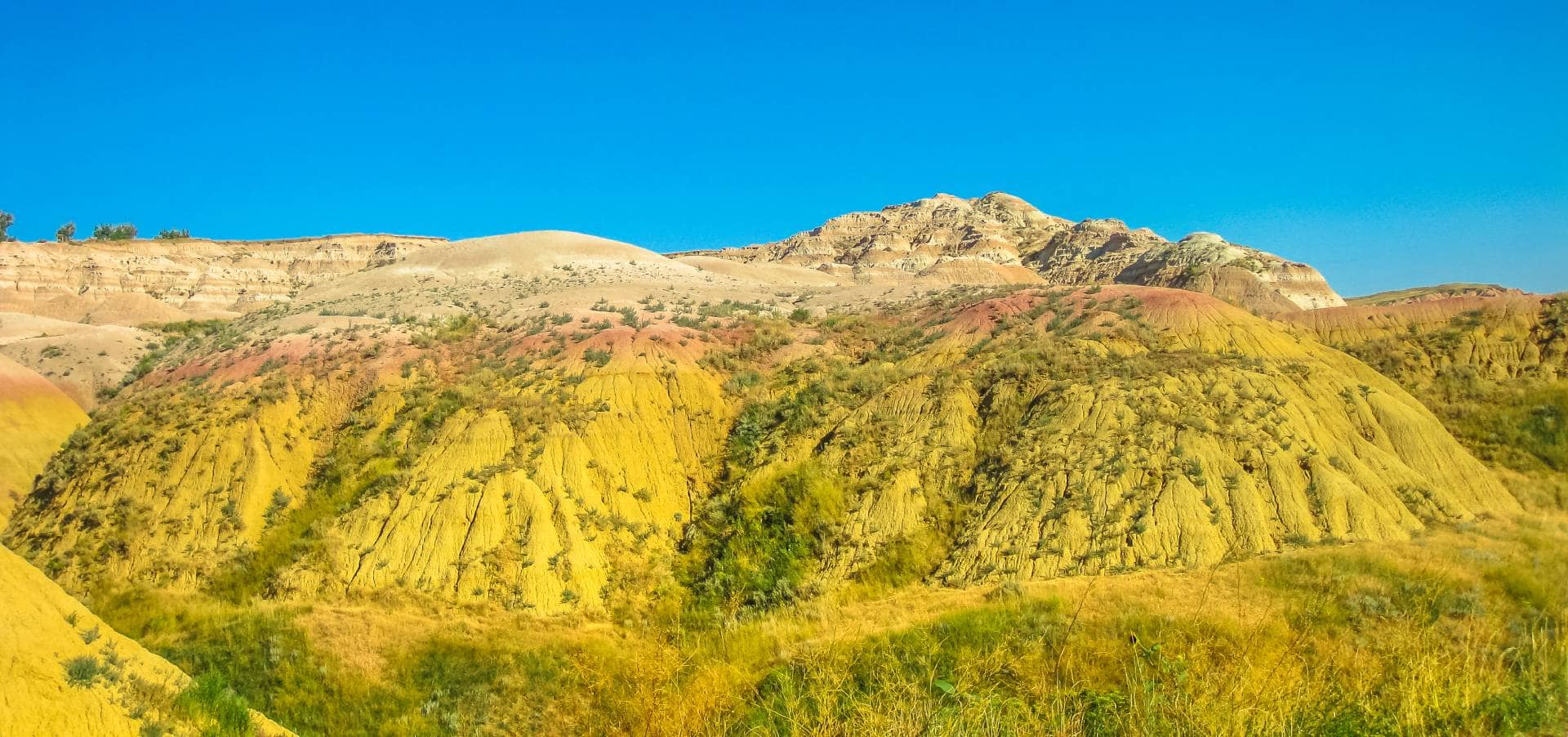
Badlands Loop Road
The Badlands Loop Road is a bit of a misnomer, as it really doesn’t circle through the park. It can be considered a loop road if you include Sage Creek Rim Road and Highway 44. If you’re driving just the portion of the road within the park, plan on spending at least three hours, which includes time at viewpoints.
Almost all the overlooks along the Badlands Loop Road are worth stopping to view the dramatic landscape and learn more about the natural and human history of the area. At the Pinnacles Overlook, you’ll often find bighorn sheep. Other highlights include the colorful Yellow Mounds and Roberts Prairie Dog Town, where you’ll see hundreds of prairie dogs poking their heads from their holes.
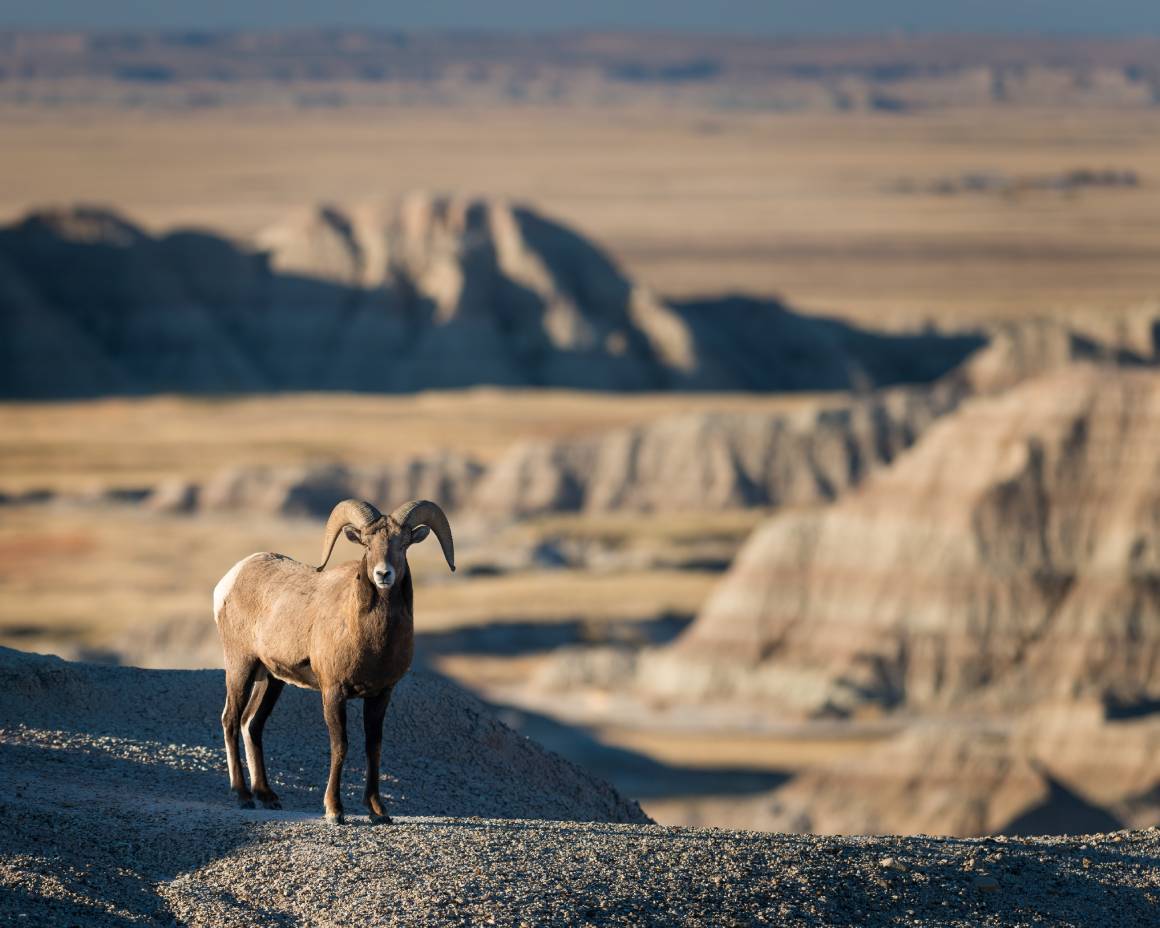
Wildlife
American bison can be seen in almost every part of the North Unit except for the area around the visitor center. As mentioned, you may also see bighorn sheep and prairie dogs, plus black-footed ferrets, bobcats, and pronghorns. Remember to keep at least 100 feet from any wild animal. If the animal is reacting to you, you’re too close!
Dinosaur finds
About five miles north of the Ben Reifel Visitor Center, the Fossil Discovery Trail is a ¼-mile, paved walk with exhibits, introducing the paleontology of the park. In the summertime, fossil talks happen here twice a day. Check with the visitor center for times.
Biking
Biking only is allowed on designated paved, gravel, and dirt roads within Badlands National Park. Cyclists should be fairly experienced. On Badlands Loop Road, they’ll find little shoulder and heavy traffic from Memorial Day to Labor Day. Water is not available along the route, so make sure to travel with plenty. For descriptions of particular loops visit nps.gov.
Stargazing
The night sky at Badlands is phenomenally clear. From Memorial Day through Labor Day, an evening ranger program is followed by star viewing at the amphitheater near Cedar Park Campground. Rangers pull out large telescopes and help you find different constellations, stars, and planets, weather permitting. With some luck, you may be able to see the International Space Station passing overhead! Night sky viewing starts around 9:45 p.m. in May, June, and July; in August and September, it starts at 9:15 p.m.
Hiking in Badlands National Park
Almost all the designated trails in the Badlands are located in the southeastern portion of the North Unit, not far from the Ben Reifel Visitor Center. But here’s the thing: Unlike nearly all the other national parks, you don’t have to stay on the trail in the Badlands. You can hike wherever you’d like!
From the parking area less than a mile east of the visitor center, you can access Cliff Shelf. The half-mile (round trip) boardwalk loops through a small grove of junipers along the Badland Wall. It has an elevation gain of 200 feet with good views of the southern portions of the park.
From the parking area about two miles northeast of the visitor center, you can access the following trails:
Door and Window Trails
The ¼-mile (round trip) Window Trail and the ¾-mile (round trip) Door Trail are easy strolls along boardwalks. A ranger typically gives an orientation talk from Door Trail in the morning.
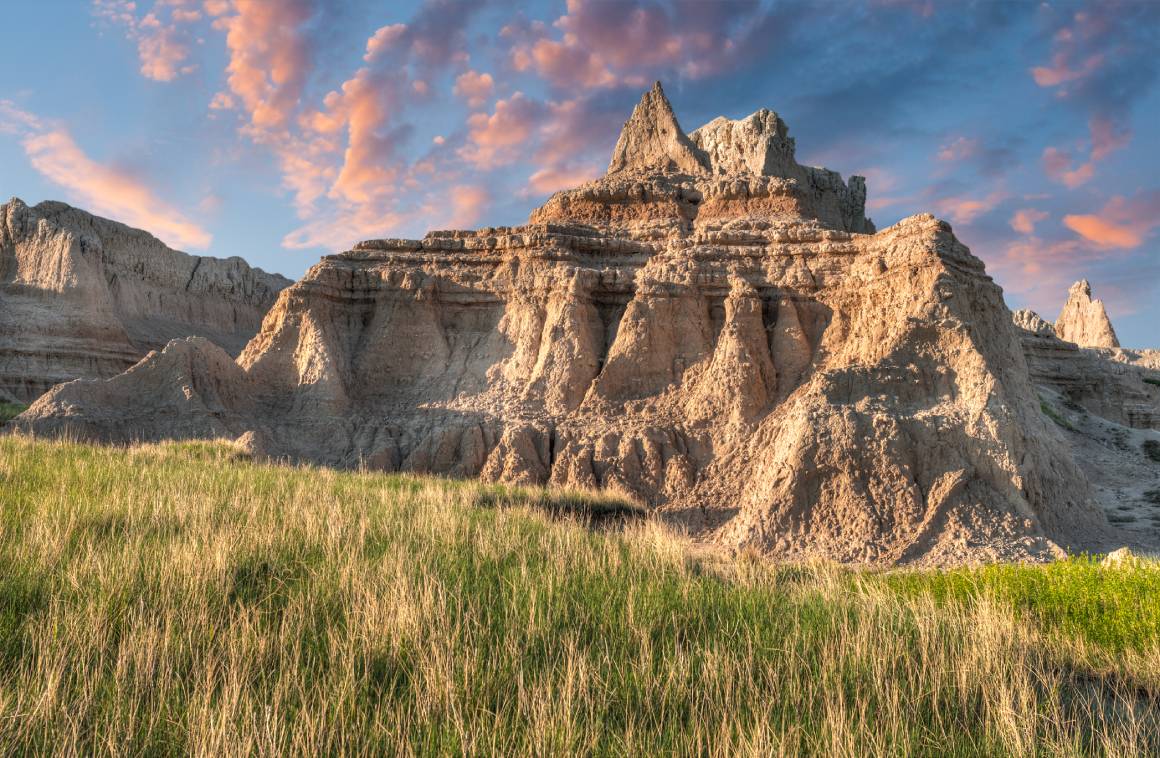
Notch Trail
A park favorite, the Notch Trail is a moderate-to-strenuous, 1 ½-mile (round trip) trail that pays off with expansive views for the White River Valley. Kids love climbing the tall, wooden ladder en route.
Castle and Medicine Root Trails
A healthy 10 miles long (round trip), the Castle Trail is a relatively flat hike through several Badland formations. It can be shortened by looping back early on the Medicine Root Trail.
Always carry water with you. It’s recommended that you bring one quart for every hour that you plan to be on the trail.
Staying in and around Badlands
Accommodations for overnight stays in the Badlands are limited. It’s imperative that you make reservations in advance.
Cabins
Cedar Pass Lodge is actually a collection of cabins near the Ben Reifel Visitor Center. The cabin interiors are lined with fallen beetle kill pine from the Black Hills and furnished with handcrafted lodgepole pine furniture from a family-owned company in Montana. Outside, you can lounge in pine deck chairs while you take in views of the Badlands. Pet-friendly cabins are available for an extra fee. Cedar Pass Lodge is open late April through late October.
Other lodging outside of the park includes Badlands Inn and Badlands Budget Host Motel in Interior.
Campgrounds
Cedar Pass Campground offers both tent and RV sites with electric hookups only. Pay showers and flush toilets are available. There are no trees, but each campsite has a shade awning over a picnic table. The campground is open from early April through mid-October.
If you stay in the park, you’ll have front row seats to the stunning sunsets. Afterwards, you can catch the ranger-led stargazing program at the Cedar Pass Amphitheater.
Sage Creek Campground is a free, primitive campground of 27 first-come, first-served sites on the western side of the North Unit. There is no water and only vault toilets. The unpaved road to the campground has limited turnarounds for large RVs and is not passable after winter storms and spring rains. Due to overcrowding, changes could be coming to this campground. Check with the visitor center for updates.
Backcountry camping
You don’t need a permit to camp in the backcountry within the park. Regulations state that you must be a ½ mile and not visible from any road or trail. Make sure not to leave anything in your car except a note on the dash stating when you’ll return. It’s best to park in an overlook, and be sure that you don’t block the road. Pack in all your water; if you find water, it’s not drinkable, even when filtered. Pack out all trash.
Other camping options outside the park include Badlands/White River KOA, Badlands Interior Campground, and Minuteman RV Park and Lodging. You’ll find more options in Wall and Rapid City.
Eating in and around Badlands National Park
Even in the summertime, there aren’t many dining choices. You may want to bring food with you.
Inside the park
Cedar Pass Restaurant is located next to the Ben Reifel Visitor Center and is open roughly from early May until mid-September. Every day, the restaurant makes its own fry bread for “Sioux Indian tacos” topped with refried beans, buffalo meat (or vegetarian option), shredded lettuce, tomato, cheddar cheese, and black olives.
Outside the park
Cowboy Corner, which is the only gas station in the town of Interior, generally offers a single item for lunch on most days but often runs out.
There are two bars in Interior. Wagon Wheel Bar and Grill is the family-friendly one that serves food.
There are small convenience stores in the towns of Interior and Scenic and near the Minuteman Missile Visitor Center, one mile south of exit 131 on Interstate 90, but they may only be open seasonally. You’ll also find a convenience store about 10 miles south of the White River Visitor Center.
You’ll discover other places to eat outside of the park in Wall and Rapid City.
How many days should you plan to spend in Badlands National Park?
You can spend anywhere from a half day to several days in the park, depending on if you want to hike or if you want to see more than one unit. If you simply want to drive the 22-mile paved portion and the 25-mile gravel portion of Badlands Loop Road, plan on three hours with stops. Otherwise, book an overnight stay in the cabins or campground, so you can witness both the sunset and the starry night sky.
If you only have one day to experience Badlands National Park, here’s a solid plan:
- Take Interstate 90 from Rapid City and stop at the Minuteman Missile Visitor Center.
- Visit the Ben Reifel Visitor Center in the North Unit and watch the park movie. Check out the paleontology lab, if you’re visiting during the summer.
- Drive to the parking area two miles northeast of the visitor center. You may be able to catch the ranger talk on the Door Trail. Regardless, don’t miss hiking the Notch Trail.
- Backtrack to the visitor center and then head out on Badlands Loop Road, stopping and taking photos at the various viewpoints including Yellow Mounds and Pinnacles Outlook where you may meet some bighorn sheep.
- When the paved road ends, continue on the gravel road. You’ll spot hundreds of prairie dogs at Roberts Prairie Dog Town. Then exit in the park in the northwestern corner. Or depending on your timing, you can double back to Pinnacles Outlook to photograph an unforgettable sunset.
What to do near Badlands National Park
Why is Badlands such a popular park? Besides its otherworldly landscape, the park fits well into an even longer South Dakota vacation that includes other major attractions in the Black Hills.
Custer State Park
Custer State Park and its 71,000 acres is located about a 1 ½-hour drive west of the Badlands. While it’s designated as a state park, it truly rivals many national parks. You have plenty of opportunities for wildlife viewing: coyotes, elk, mule and white-tailed deer, pronghorns, prairie dogs, bighorn sheep, and mountain goats. But most people come to see the majestic herd of American bison and the friendly wild burros who’ll walk right up to your car. You can stay overnight at the lodge, in modern cabins, or at the campground.
Mount Rushmore National Memorial
A must-see for all Americans, Mount Rushmore National Memorial is about two hours from the Ben Reifel Visitor Center. Join a free ranger-led tour or walk the Presidential Trail on your own.
Plan your visit for late afternoon or early evening so that you can see the monument during the daylight and then stick around for the lighting ceremony at dusk.
Crazy Horse Memorial
Just 30 minutes from Mount Rushmore, you can see another massive monument in granite—this one still in progress. Started in 1948 by sculptor Korczak Ziolkowski, only a fraction of the Crazy Horse Memorial is complete. Ziolkowski’s descendants continue to work on the sculpture of the Lakota Sioux chief seated on his horse. Inside the Welcome Center, you can learn the story of how this project came to be.
Wind Cave National Park
Wind Cave National Park is home to one of the longest and most complex cave systems in the world. It has the largest collection of boxwork, a rare, honeycomb-like mineral formation that hangs from the cave’s ceiling. To visit Wind Cave, you must book a ranger-led tour. Some tours can be reserved in advance; others are first come, first served.
Jewel Cave National Monument
Jewel Cave National Monument is about 32 miles from Wind Cave and also offers guided tours.
Deadwood
From Gold Rush miners and madams to gamblers and gunslingers, all sorts of people have walked the streets of Deadwood. In fact, Wild Bill Hickok was shot dead in Deadwood’s No. 10 Saloon. Especially during the summer, you’ll find plenty to entertain yourself with in the Wild West town, including historical re-enactments.
Image header credit: Shutterstock
